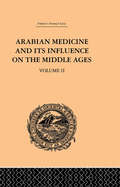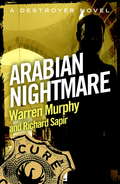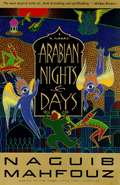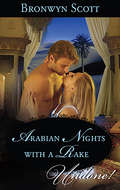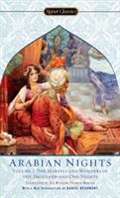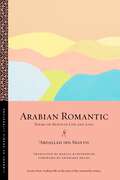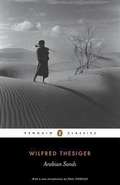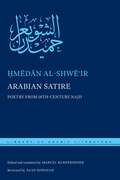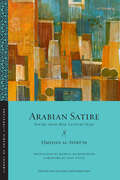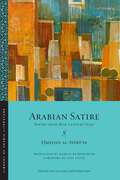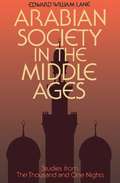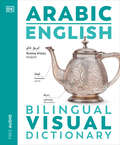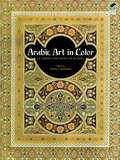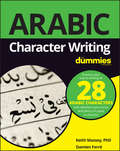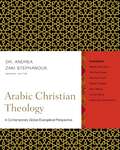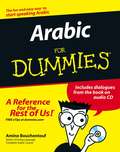- Table View
- List View
Arabian Medicine and its Influence on the Middle Ages: Volume II (Trubner's Oriental Ser.)
by Donald CampbellFirst Published in 2000. Routledge is an imprint of Taylor & Francis, an informa company.
Arabian Nightmare: Number 86 in Series (The Destroyer #86)
by Warren Murphy Richard SapirRemo and Chiun face a diabolical dictator and a female fiend in a middle eastern hell.
Arabian Nights
by Heather GrahamAn Egyptologist teams up with an arrogant but gorgeous reporter to find her missing father in this romance from the New York Times–bestselling author. Days before starting a history-making excavation in a remote sector of the Valley of the Kings, Dr. Alexandria Randall&’s father, a fellow Egyptologist, goes missing. Alex will stop at nothing to find her father—a gargantuan task in an ancient land where she doesn&’t make the rules—even if she&’s also a target. Alex must swallow her pride and ask for protection from an arrogant journalist named Dan. To find her father, Alex must play Dan&’s wife—a ruse that both find insufferable. But with her father&’s life hanging in the balance, Alex is determined to make their mock marriage work. This ebook features an illustrated biography of Heather Graham including rare photos from the author&’s personal collection.
Arabian Nights Illustrated: Art of Dulac, Folkard, Parrish and Others
by Jeff A. MengesAccording to legend, a resourceful bride won a stay of execution by captivating a sultan with a series of fantastic tales--and after 1,001 nights, the sultan could not bear to part with his storyteller. More than a thousand years later, readers continue to fall under the spell of the romantic adventures known as the Arabian Nights. This original collection features rare and unusual illustrations inspired by the traditional tales of Sinbad, Aladdin, Ali Baba, and a host of other exotic characters.Spanning the decades between the 1890s and the 1920s, this volume draws upon images from the Golden Age of Illustration, when technological advances in printing led to a boom in the publication of artwork. Drawings and paintings by Maxfield Parrish, Edmund Dulac, Charles Folkard, and other acclaimed artists of the era appear here, in more than 185 color and black-and-white illustrations with captions. Abounding in mystery and excitement, these scenes from the timeless tales of heroism will captivate all lovers of fantasy and fairy tales, as well as collectors of rare books and art and illustration enthusiasts.
Arabian Nights and Days
by Naguib MahfouzA renowned Nobel Prize-winning novelist refashions the classic tales of Scheherazade in his own imaginative, spellbinding style. Here are genies and flying carpets, Aladdin and Sinbad, Ali Baba, and many other familiar stories, made new by the magical pen of the acknowledged dean of Arabic letters.
Arabian Nights and Days: A Novel
by Naguib Mahfouz Denys Johnson-DaviesA renowned Nobel Prize-winning novelist refashions the classic tales of Scheherazade in his own imaginative, spellbinding style. Here are genies and flying carpets, Aladdin and Sinbad, Ali Baba, and many other familiar stories, made new by the magical pen of the acknowledged dean of Arabic letters.
Arabian Nights with a Rake
by Bronwyn ScottAlgerian Desert, 1833Held captive in a Bedouin camp, Susannah Sutcliffe was bid to dress in scandalous silks and dance for the sheikh's guests. The request wasn't new to Susannah--but the presence of English diplomat Alex Grayfield was a shock she had not anticipated! Handsome and charming, Alex exuded a powerful masculinity that Susannah found irresistible...and he was unmistakably aroused by her sensual dance. Soon, Susannah had a plan to escape her desert captors: convince Alex to rescue her--by seducing him....
Arabian Nights: The Marvels and Wonders of the Thousand and One Nights
by Sir Richard Francis Burton Jack ZipesAfter King Shahryar had his wife killed for cheating, he began to corrupt--then kill--one virgin a night, as revenge on womankind. Then he meets Scheherazade, who, night after night, saves her own life by telling him fantastical tales of genies, wishes, terror, and passion. Famous stories from here are Aladdin and His Magic Lamp, Ali Baba and the Forty Thieves, and others. Frequent telling of sexual activities through analogy. There is a glossary at the end, which would be helpful to read before beginning. The original (supposedly) 30 volumes were later whittled down to 10 volumes, and now to one volume of the major stories and other of lesser stories.
Arabian Oasis City: The Transformation of Unayzah
by Soraya Altorki Donald P. ColeVast social change has occurred in the Middle East since the oil boom of the mid-1970s. As the first anthropological study of an urban community in Saudi Arabia since that oil boom, Arabian Oasis City is also the first to document those changes. Based on extensive interviews and participant observation with both men and women, the authors record and analyze the transformation that has occurred in this ancient oasis city throughout the twentieth century: the creation of the present Saudi Arabian state and of a new national economy based on the export of oil and the economic boom brought about by the dramatic increases in the price of oil following the October 1973 Arab-Israeli War. In addition, the authors reveal the changes brought about by the fall in the price of oil beginning in 1982 and analyze the problems confronting 'Unayzah in its aftermath. By demonstrating that the area was not exclusively dominated by tribalism and Bedouin nomads, this empirical case study destroys stereotypical views about Saudi Arabia. Indeed, it proves the existence-prior to the coming of the modern Saudi Arabian state-of surplus agricultural and craft production and the full development of local, regional, and long-distance trade networks. It shows that women, although veiled, played active roles in work outside the household. The social impact of change over the years is, however, profound-especially the gradual replacement of the extended family by the nuclear family, changing patterns of husband-wife relationships, the impact of self-earned income on the status of women, and the emergence of a new middle class of employees and entrepreneurs. Because of the high degree of gender segregation in this area of research, Altorki and Cole give us a fortunate collaboration between a Saudi Arabian female scholar and an American male scholar experienced in research in the Middle East. Both are professors of anthropology at the American University in Cairo.
Arabian Plate and Surroundings: Geology, Sedimentary Basins and Georesources (Regional Geology Reviews)
by Sami Khomsi François M. Roure Mansour Al Garni Ammar AminThis book focuses on the evolution of sedimentary basins of the Arabian Plate and its surroundings. Because these sedimentary basins developed in various tectonic settings, from extensional or transtensional to flexural, transpressional or compressional, their sedimentary sequences provide unique records of the regional geology. Georesources of the Arabian Plate are also described here, including petroleum potential, reservoirs, water resources, fresh water and deep saline aquifers, as well as materials and ore deposits. The book is made by a set of papers authored by geoscientists working in both academia and industry. Numerous chapters describe some regional important geologic features and selected sedimentary basins from the Middle East, North Africa and the Arabian Peninsula domains. Other chapters focus on georesources. A particular focus is given to the geology of Saudi Arabia. This book is an important contribution to the geology of the Arabian Peninsula and its surroundings. In view of the strategic and economic importance of the regional geology and georesources of the Arabian Plate and Surroundings, this volume will constitute an important reference for a wide range of geoscientists interested in the geology of this region, especially those active in petroleum geosciences and related industry. Ultimately, readers will discover important thematic maps in this book.
Arabian Romantic: Poems on Bedouin Life and Love (Library of Arabic Literature #33)
by ʿAbdallāh ibn SbayyilLove poems from late nineteenth-century Arabia Arabian Romantic captures what it was like to live in central Arabia before the imposition of austere norms by the Wahhabi authorities in the early twentieth century: tales of robbery and hot pursuit; perilous desert crossings; scenes of exhaustion and chaos when water is raised from deep wells under harsh conditions; the distress of wounded and worn-out animals on the brink of perdition; once proud warriors who are at the mercy of their enemy on the field of battle. Such images lend poignancy to the suffering of the poet’s love-stricken heart, while also painting a vivid portrait of typical Bedouin life. Ibn Sbayyil (ca. 1853–1933), a town dweller from the Najd region of the Arabian Peninsula, was a key figure in the Nabati poetic tradition. His poetry, which is still recited today, broke with the artifice of the preceding generation by combining inherited idiom and original touches reflecting his environment. Translated into English for the first time by Marcel Kurpershoek, Arabian Romantic will delight readers with a poetry that is direct, fluent, and expressive, and that has entertained Arabic speakers for over a century.A bilingual Arabic-English edition.
Arabian Romantic: Poems on Bedouin Life and Love (Library of Arabic Literature #69)
by ʿAbdallāh ibn SbayyilScenes from Arabian life at the turn of the twentieth centuryArabian Romantic captures what it was like to live in central Arabia before the imposition of austere norms by the Wahhabi authorities in the early twentieth century: tales of robbery and hot pursuit; perilous desert crossings; scenes of exhaustion and chaos when water is raised from deep wells under harsh conditions; the distress of wounded and worn-out animals on the brink of perdition; once proud warriors who are at the mercy of their enemy on the field of battle. Such images lend poignancy to the suffering of the poet’s love-stricken heart, while also painting a vivid portrait of typical Bedouin life.Ibn Sbayyil, a town dweller from the Najd region of the Arabian Peninsula, was a key figure in the Nabaṭī poetic tradition. His poetry, which is still recited today, broke with the artifice of the preceding generation by combining inherited idiom and original touches reflecting his environment. Translated into English for the first time by Marcel Kurpershoek, Arabian Romantic will delight readers with a poetry that is direct, fluent, and expressive, and that has entertained Arabic speakers for over a century.An English-only edition.
Arabian Sands
by Rory Stewart Wilfred ThesigerIn Arabian Sands, William Thesiger charts the time he spent living with the Bedu, including his legendary traverses of the Empty Quarter.
Arabian Satire: Poetry from 18th-Century Najd (Library of Arabic Literature #49)
by Ḥmēdān al-ShwēʿirThis lively volume collects poems by Hmedan al-Shwe'ir, who lived in Najd in the Arabian Peninsula shortly before the hegemony of the Wahhabi movement in the early eighteenth century.A master of satire known for his ribald humor, self-deprecation, and invective verse (hija'), Hmedan was acerbic in his criticisms of society and its morals, voiced in in a poetic idiom that is widely referred to as “Nabati,” here a mix of Najdi vernacular and archaic vocabulary and images dating back to the origins of Arabic poetry. In Arabian Satire, Hmedan is mostly concerned with worldly matters, and addresses these in different guises: as the patriarch at the helm of the family boat and its unruly crew; as a picaresque anti-hero who revels in taking potshots at the established order, its hypocrisy, and its moral failings; as a peasant who labors over his palm trees, often to no avail and with no guarantee of success; and as a poet recording in verse how he thinks things ought to be.The poems in Arabian Satire reveal a plucky, headstrong, yet intensely socially committed figure—representative of the traditional Najdi ethos—who infuses his verse with proverbs, maxims, and words of wisdom expressed plainly and conversationally. Hmedan is accordingly quoted by historians of the Gulf region and in anthologies of popular sayings. This is the first full translation of this remarkable poet. A bilingual Arabic-English edition.
Arabian Satire: Poetry from 18th-Century Najd (Library of Arabic Literature #62)
by Ḥmēdān Al-ShwēʿirSatirical verse on society and its hypocrisiesA master of satire known for his ribald humor, self-deprecation, and invective verse (hijāʾ), the poet Ḥmēdān al-Shwēʿir was an acerbic critic of his society and its morals. Living in the Najd region of the Arabian Peninsula, Ḥmēdān wrote in an idiom widely referred to as “Nabaṭī,” here a mix of Najdī vernacular and archaic vocabulary and images dating to the origins of Arabic poetry. In Arabian Satire, Ḥmēdān is mostly concerned with worldly matters and addresses these in different guises: as the patriarch at the helm of the family boat and its unruly crew; as a picaresque anti-hero who revels in taking potshots at the established order, its hypocrisy, and its failings; as a peasant who labors over his palm trees, often to no avail and with no guarantee of success; and as a poet recording in verse how he thinks things ought to be.The poems in Arabian Satire reveal a plucky, headstrong, yet intensely socially committed figure—representative of the traditional Najdī ethos—who infuses his verse with proverbs, maxims, and words of wisdom expressed plainly and conversationally. Ḥmēdān is widely quoted by historians of the Gulf region and in anthologies of popular sayings. This is the first full translation of this remarkable poet.An English-only edition.
Arabian Satire: Poetry from 18th-Century Najd (Library of Arabic Literature #62)
by Ḥmēdān al-ShwēʿirSatirical verse on society and its hypocrisiesA master of satire known for his ribald humor, self-deprecation, and invective verse (hijāʾ), the poet Ḥmēdān al-Shwēʿir was an acerbic critic of his society and its morals. Living in the Najd region of the Arabian Peninsula, Ḥmēdān wrote in an idiom widely referred to as “Nabaṭī,” here a mix of Najdī vernacular and archaic vocabulary and images dating to the origins of Arabic poetry. In Arabian Satire, Ḥmēdān is mostly concerned with worldly matters and addresses these in different guises: as the patriarch at the helm of the family boat and its unruly crew; as a picaresque anti-hero who revels in taking potshots at the established order, its hypocrisy, and its failings; as a peasant who labors over his palm trees, often to no avail and with no guarantee of success; and as a poet recording in verse how he thinks things ought to be.The poems in Arabian Satire reveal a plucky, headstrong, yet intensely socially committed figure—representative of the traditional Najdī ethos—who infuses his verse with proverbs, maxims, and words of wisdom expressed plainly and conversationally. Ḥmēdān is widely quoted by historians of the Gulf region and in anthologies of popular sayings. This is the first full translation of this remarkable poet.An English-only edition.
Arabian Society Middle Ages: Studies From The Thousand And One Nights
by Edward William Lane Clifford Edmund Bosworth Stanley Lane-PooleFirst Published in 1995. Routledge is an imprint of Taylor & Francis, an informa company.
Arabians and Other Horses (World Book's Animals of the World)
by Karen IngebretsenIn a question and answer format the author introduces the Arabian horse and also discusses caring for a horse.
Arabic
by Karin C. RydingThis new edition, updated and with additional exercises, equips those who work, travel, and study in Arab countries with an educated form of spoken Arabic that functions flexibly in the face of various regional colloquial variants in the Arab world. Because the Arabic language has a number of very different spoken vernaculars, being able to speak and be understood in all Arab countries has become a challenge for English speakers. Ryding and Mehall have designed a course that teaches a standardized variant of spoken Arabic that is close to, but more natural than, the literary Modern Standard Arabic. With a non-grammar-based approach, this book fosters communicative competence in Arabic on all levels and develops speaking proficiency without abandoning Arabic script. It has proven to be clear, effective, and relevant to the needs of Americans living and working in the Arab East. Task-based lessons feature basic dialogues between Americans and Arabs, explanations of new structures, vocabulary expansion, and exercises; and provide gradual access to the sounds and script of Arabic by emphasizing listening and reading comprehension first, then slowly adding oral exercises and activities until the student has achieved basic proficiency. Not intended for self-instruction for beginners, Formal Spoken Arabic Basic Course with MP3 Files assumes some previous knowledge of Modern Standard Arabic, Arabic script and phonology, and previous or simultaneous instruction in orthography. This new edition includes a CD of MP3 audio exercises that are keyed to the text and drill students on listening and speaking. Lessons cover topics including:Heads of StateCities and CountriesOfficial TitlesGeographySystems of GovernmentLost LuggageGetting AcquaintedEstablishing Common GroundSeeking and Giving InformationPersonal Needs and FamilyHandling ProblemsEating OutBargaining and Buying
Arabic - English Bilingual Visual Dictionary (DK Bilingual Visual Dictionaries)
by DKWith more than 6,750 fully illustrated words and phrases in Arabic and English, along with a free bilingual audio app, DK's Arabic-English Bilingual Visual Dictionary is your essential companion to learning Arabic.You will find all the words and phrases you need to buy food and clothes, talk about work and education, visit the doctor, go to the bank, use public transportation, and much more. Perfect for students, tourists, and business travelers, the dictionary is incredibly easy to follow, with thematically organized vocabulary so you can find closely related words on a particular topic. Words and phrases are illustrated with full-color photographs and artwork, helping to fix new vocabulary in your mind. The supporting audio app enables you to hear all the words and phrases spoken out loud in both languages to help you learn, remember, and pronounce important vocabulary.
Arabic Art in Color
by Prisse D’avennesHere are 141 designs and motifs in authentic full color from classic 19th century work by noted French historian -- a visual vocabulary of Islamic decorative art.
Arabic As A Secret Song (CARAF Books: Caribbean and African Literature Translated from French)
by Skyler ArtesThe celebrated and highly versatile writer Leïla Sebbar was born in French colonial Algeria but has lived nearly her entire adult life in France, where she is recognized as a major voice on the penetrating effects of colonialism in contemporary society. The dramatic contrast between her past and present is the subject of the nine autobiographical essays collected in this volume. Written between 1978 and 2006, they trace a journey that began in Aflou, Algeria, where her father ran a schoolhouse, and continued to France, where Sebbar traveled, alone, as a graduate student before eventually realizing her powerful creative vision. The pieces collected in this book capture an array of experiences, sensations, and sentiments surrounding the French colonial presence in Algeria and offer an intimate and prismatic reflection on Sebbar’s bicultural upbringing as the child of an Algerian father and French mother. Sebbar paints an unflinching portrait of her original disconnection from her father’s Arabic language and culture, depicting her struggle to revive a cultural heritage that her family had deliberately obscured and to convey the vibrant yet muted Arabic of her father and of Algeria. Looking back from numerous vantage points throughout her life, she presents the complicated and divisive dynamics of being raised "between two shores"--the colonized and the colonizer. CARAF Books: Caribbean and African Literature Translated from French
Arabic Character Writing For Dummies
by Keith Massey Damien FerréLearn to write in Arabic In Arabic, there are different levels of language. The written language, which is studied in this book, is literary Arabic, sometimes also called classical Arabic or even modern or standard Arabic. It is the language of the Quran, classical poetry, literature and the media. The Arabic plume consists of 28 consonants and three long vowels. Each consonant is accompanied by a vowel which is placed above or below the consonant. Arabic speakers are in great demand in the United States, due to the country's political commitments to the Middle East, but only 25 percent of non-native speakers know the language in enough detail to function as translators, interpreters, analysts, or field agents. Arabic Character Writing For Dummies helps you write this language clearly and correctly. Learn to write the Arabic alphabet Find free instructional videos, flashcards, and printable writing pages online Build upon your mastery of the language Get ahead at work or in your personal life Arabic Character Writing For Dummies is designed for beginners, students, and lifelong learners wishing to write in Arabic.
Arabic Christian Theology: A Contemporary Global Evangelical Perspective
by ZondervanTheology is not done in a vacuum. Our theology is affected by the culture in which we live, and our theology can have unexpected effects on the lives of Christians who live thousands of miles away. This point emerges clearly as we listen to seven Arabic evangelical theologians address issues that are of critical importance to Christians living as minorities in the Muslim world. North American readers may find that many of their assumptions are challenged as they see how respected Christian thinkers from a very different context address issues of biblical interpretation, national and international politics, culture and gender.
Arabic For Dummies
by Amine BouchentoufRegarded as one of the most difficult languages to learn for native English speakers by the U. S. State Department, Arabic is gaining both prominence and importance in America. Recent world events have brought more and more Americans and other English speakers into contact with Arabic-speaking populations, and governments and businesses are increasingly aware of the importance of basic Arabic language skills. Arabic for Dummies provides you with a painless and fun way to start communicating in Arabic. Why should you learn Arabic? Well, besides the fact that over 200 million people in more than 22 nations use it to communicate, there are tons of reasons to get up to speed this 1,400 year old language, including: Nearly all of the Middle-East speaks Arabic or one of its dialects Basic Arabic skills are extremely useful for anyone traveling to, doing business in, or serving in the Middle East It is the language in which the Koran is written There is a rich, centuries-old literary tradition in Arabic Arabic For Dummies presents the language in the classic, laid-back For Dummies style. Taking a relaxed approach to this difficult language, it's packed with practice dialogues and communication tips that will have you talking the talk in no time. You'll get the scoop on: The Arabic alphabet, pronunciation, basic grammar, and the rules of transliteration The history of the language and information on classical Arabic and its dialects How to make small talk and make yourself understood when dining, shopping, or traveling around town How to communicate on the phone and in business conversations Handy words and phrases for dealing with money, directions, hotels, transportation, and emergencies Arabic culture and etiquette, including ten things you should never do in Arabic countries The book also includes an Arabic-English dictionary, verb tables, and an audio CD with dialogues from the book to help you perfect your pronunciation. Written by a native Arabic speaker who helped start a year-round Arabic department at Middlebury College, Arabic For Dummies is just what you need to start making yourself understood in Arabic. Note: CD-ROM/DVD and other supplementary materials are not included as part of eBook file.
